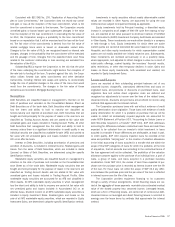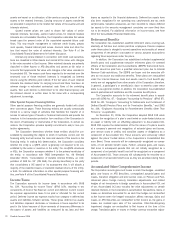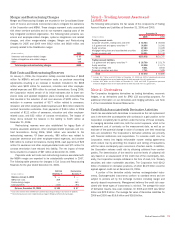Bank of America 2006 Annual Report Download - page 113
Download and view the complete annual report
Please find page 113 of the 2006 Bank of America annual report below. You can navigate through the pages in the report by either clicking on the pages listed below, or by using the keyword search tool below to find specific information within the annual report.ments are reclassified to Net Income upon the substantial sale or liqui-
dation of investments in foreign operations.
Earnings Per Common Share
Earnings per Common Share is computed by dividing Net Income Available
to Common Shareholders by the weighted average common shares issued
and outstanding. For Diluted Earnings per Common Share, Net Income
Available to Common Shareholders can be affected by the conversion of
the registrant’s convertible preferred stock. Where the effect of this con-
version would have been dilutive, Net Income Available to Common Share-
holders is adjusted by the associated preferred dividends. This adjusted
Net Income is divided by the weighted average number of common shares
issued and outstanding for each period plus amounts representing the
dilutive effect of stock options outstanding, restricted stock, restricted
stock units and the dilution resulting from the conversion of the regis-
trant’s convertible preferred stock, if applicable. The effects of convertible
preferred stock, restricted stock, restricted stock units and stock options
are excluded from the computation of diluted earnings per common share
in periods in which the effect would be antidilutive. Dilutive potential
common shares are calculated using the treasury stock method.
Foreign Currency Translation
Assets, liabilities and operations of foreign branches and subsidiaries are
recorded based on the functional currency of each entity. For certain of the
foreign operations, the functional currency is the local currency, in which
case the assets, liabilities and operations are translated, for consolidation
purposes, at period-end rates from the local currency to the reporting cur-
rency, the U.S. dollar. The resulting unrealized gains or losses are
reported as a component of Accumulated OCI on an after-tax basis. When
the foreign entity’s functional currency is determined to be the U.S. dollar,
the resulting remeasurement currency gains or losses on foreign denomi-
nated assets or liabilities are included in Net Income.
Credit Card Arrangements
Endorsing organization agreements
The Corporation contracts with other organizations to obtain their endorse-
ment of the Corporation’s loan products. This endorsement may provide
the Corporation exclusive rights to market to the organization’s members
or to customers on behalf of the Corporation. These organizations endorse
the Corporation’s loan products and provide the Corporation with their
mailing lists and marketing activities. These agreements generally have
terms that range from five to seven years. The Corporation typically pays
royalties in exchange for their endorsement. These compensation costs to
the Corporation are recorded as contra-revenue against Card Income.
Cardholder reward agreements
The Corporation offers reward programs that allow its cardholders to earn
points that can be redeemed for a broad range of rewards including cash,
travel and discounted products. The Corporation establishes a rewards
liability based upon the points earned which are expected to be redeemed
and the average cost per point redemption. The points to be redeemed are
estimated based on past redemption behavior, card product type, account
transaction activity and other historical card performance. The liability is
reduced as the points are redeemed. The estimated cost of the rewards
programs is recorded as contra-revenue against Card Income.
Stock-based Compensation
On January 1, 2006, the Corporation adopted SFAS 123R under the
modified-prospective application. The Corporation had previously adopted
the fair value-based method of accounting for stock-based employee
compensation under SFAS No. 148, “Accounting for Stock-Based Compen-
sation – Transition and Disclosure – an amendment of FASB Statement
No. 123,” (SFAS 148) prospectively, on January 1, 2003. Had the Corpo-
ration adopted SFAS 148 retrospectively, the impact in 2005 and 2004
would not have been material. For additional information on stock-based
employee compensation, see Note 17 of the Consolidated Financial
Statements.
Note 2 – MBNA Merger and Restructuring
Activity
The Corporation acquired 100 percent of the outstanding stock of MBNA
on January 1, 2006, for $34.6 billion. In connection therewith
1,260 million shares of MBNA common stock were exchanged for
631 million shares of the Corporation’s common stock. Prior to the MBNA
merger, this represented approximately 16 percent of the Corporation’s
outstanding common stock. MBNA shareholders also received cash of
$5.2 billion. The MBNA merger was a tax-free merger for the Corporation.
The acquisition expands the Corporation’s customer base and its oppor-
tunity to deepen customer relationships across the full breadth of the
Corporation by delivering innovative deposit, lending and investment prod-
ucts and services to MBNA’s customer base. Additionally, the acquisition
allows the Corporation to significantly increase its affinity relationships
through MBNA’s credit card operations and sell these credit cards through
our delivery channels (including the retail branch network). MBNA’s results
of operations were included in the Corporation’s results beginning Jan-
uary 1, 2006.
Bank of America 2006
111
























